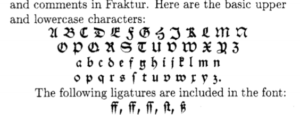This post will be for notes on typesetting.
Wikipedia is a mess on the topic of phonetics. I could do a lot of good editing there. The writers have no idea how to write a useful article. The articles all need links to sound files, and translation of technical linguistics notation and terms to ordinary language.
##################################################################
.
Gothic Typefaces. I’m trying to read Martin Luther’s New Testament. My edition has the Vulgate, a Greek version, King James, and Luther. The Luther translation is in Gothic font, probably in Schwabacher rather than the Fraktur which was standard in Germany in 1900. It is surprisingly hard to find a key to it on the web. There are lots of presentations of it, all pretty bad (they don’t help with terminal vs ordinary S, for example).
A pretty good article is “Typesetting Old German: Fraktur, Schwabacher, Gotisch and Initials,” by Yannis Haralambous, U. F. R. de MathCmatiques, University of Lille.

It’s curious that in 1941 the Nazis banned Gothic typeface in Germany, and humorous that they accused it of being a Jewish invention.
##################################################################
.
WordPress and HTML. WordPress has a very odd relation to HTML. WordPress can’t handle blank spaces or diacritical marks properly. With diacritical marks, it varies where it puts them— above, or after– depending on which letter they are connected to. Blank spaces are ignored.
https://www.w3schools.com/charsets/ref_utf_diacritical.asp
769 accent-é
770 hat-ê
771 Tildẽ
772 thinoverlinē
773 Fatoverline̅
774 cup-ĕ
775 doṫ
THe below ones do not work properly:
769 accent́
770 hat̂
774 cup̆
éĺíminate
Nonbreakingspace&nbs;Nonbreakingspace
sdfds sdfsdf
##################################################################